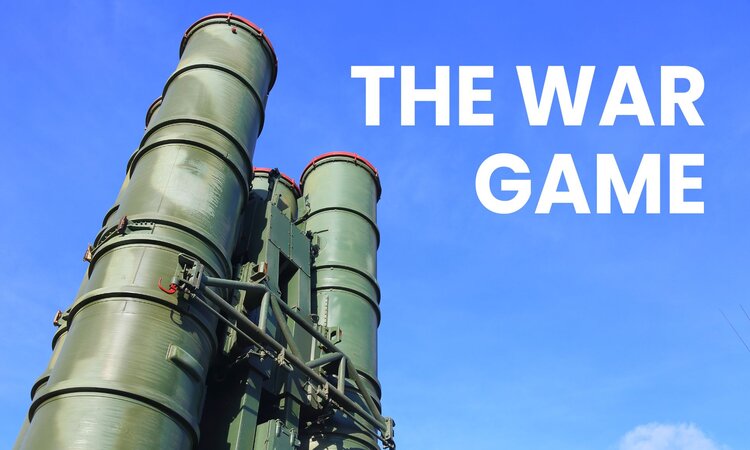The Sports Economy – What it means for India
The concept of sports has changed from what it used to be three decades back. I remember when we were kids, cricket was still a gentleman's game and we had only tests and one-day matches. There would be a yearly cricket season and a cricket world cup every 4 years and all teams were dressed in spotless white. Some of the matches would reach us through "Doordarshan" (India's public service television broadcaster, established in 1959) and most through newspaper reports. Another super craze was soccer – WORLD CUP, then the Olympics and Lawn Tennis… we had the privilege of watching quarter finals onwards.
CUT TO Present day....
All sorts of sports events from all around the world are all over the sports channels – every hour of every day. CRICKET is now not simply a game. It's now more like a festival celebrated in all forms all over the country. We just don't see the live matches or highlights on designated sports channels – we now see, eat, drink, think and live the game. What made this revolution happen ??? The 50-50 matches and Our very own IPL … the Indian Premier League.
The IPL is amongst the most exciting and awaited cricket leagues in the country featuring some of the best talents in world cricket - cricketers who outshine even the film stars in terms of popularity, joining city-based teams in defending their titles and winning the trophies. It is a Twenty20 (T20) league, organized by the Board of Control for Cricket in India (BCCI), where teams bid to acquire cricketers to play for them [1].
From a simple sports league, the IPL has now grown and morphed into a "decacorn". Decacorn refers to a company that is privately held and is valued at more than $10 billion. IPL's brand value has surged to $12 billion as of March 2025 [2]. According to an analysis by India Today's Data Intelligence Unit IPL's brand valuation surged by 433% within a 15-year span - from the date of its launch in 2008 to 2023 [3]. It's massive – imagine what could have happened if you would have had a stake in IPL. It demonstrates how commercialization helps an activity enlarge and expand exponentially.
But what has it got to do with the rest of the economy?
Hosting sports events, construction of sports facilities, and drawing sports tourists has the potential to boost local businesses alongside job creation [4]. Sports events at such an expansive and expensive level has significant influence on the economy. Let's try to understand the impact on the greater economy, step by step.
Thinks about the auction of the media rights. According to BBC report in 2022, the streaming and TV rights for the Indian Premier League - the world's richest cricket competition - for the next five years have been sold for a record $6.02bn (£5.13bn). Viacom18, backed by billionaire Mukesh Ambani, secured streaming rights until 2027 for $3.05bn. [5]. This created revenue inflow for the company.
Think about the 'pre-commencement days' of the league. A massive publicity drive is carried out – from TV, to social media, from hoardings and billboards to newspapers, advertisements are everywhere – it boosts the advertising industry, draws viewers, raises TRPs for the channels hosting the event generating revenue for all the players involved. The advertising industry gets a boost.
The cities in which such mammoth events are hosted see a surge in tourist inflow – the direct impact is on hospitality, food and beverage, transportation and FMCG sectors. On the day of the event, in and around the stadium there would be vendors selling food, beverages and merchandizes. Several small-time vendors, who otherwise may not be able to generate a decent revenue every month, would see their products getting sold. For instance you would see temporary tea and snacks shops cropping up in close proximity of the stadium, vendors, on foot, selling jerseys, t-shirts, caps, and other merchandises with team logos and themes and fans would buy at various prices, ticket prices would shoot through the roof but people would still buy them at exorbitant prices … while it generates revenue for the hosts it also gives rise to a black market for tickets as crazy fans would spend any amount to get a ticket … but that's an altogether different discussion.
Roads around the event location get repaired, beautified, new transportation routes opened up to facilitate spectator movements to and from the stadium, additional busses, taxis, trains, flights etc may be provided. The bottom line is, money flows through the entire system in huge volume. Infrastructure is built and employment is generated, although some may be temporary, and demand is created.
The Impact of IPL on the Indian Economy
The IPL has an important positive impact on the domestic economy. It contributes a massive sum of money annually through sale of media rights, tourism, and most job creation. Besides boosting tons of local businesses in the manner described above, IPL generates revenue for the hospitality and transport sectors, and most importantly stimulates infrastructure development in host cities. The Indian Premier League has contributed significantly towards infrastructure development in the country, mainly through the construction of new stadiums and renovation of the old ones. Hosting IPL matches has resulted in the improvements in transportation facilities, enhancement of amenities, and overall stadium facilities, which not only benefits the consumers in terms of sporting experience but also provides significant boost to the local economy.
India's sports economy is currently valued at $52 billion and is projected to grow at a 14% CAGR, reaching $130 billion by 2030 as per Deloitte estimates. That's almost double the speed of India's GDP growth [6].
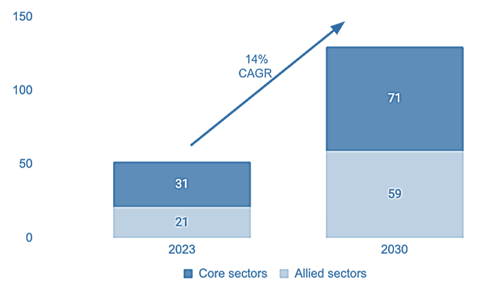
Figure 1: India's Sports Economy ($bn) - Projected Growth (Source: Deloitte)
The IPL also pushes economic growth by boosting the media industry. It offers an excellent platform for advertising and branding, increases viewership significantly and creates extensive media exposure. According to data from the Broadcast Audience Research Council (BARC), on TV the opening weekend of TATA IPL 2025 saw viewership reaching new records, as the event drew more than 25.3 crore viewers, thus clocking an unprecedented 2,770 crore minutes of watch time which reflects a 22% year-on-year surge. The average Television Viewer Rating or TVR for the first 3 matches was jumped by 39%, year-on-year [7]. Jio Cinema, the Reliance group digital streaming platform, struck partnership with 18 sponsors and 250 advertisers [4]. Peak concurrency stood at 3.4 crore alongside 137 crore views, and a staggering 2,186 crore minutes of watch time were recorded for just the first 3 matches of IPL 2025, helping JioHotstar to set new yardsticks and to capture India's pulse in an unprecedented way [7].
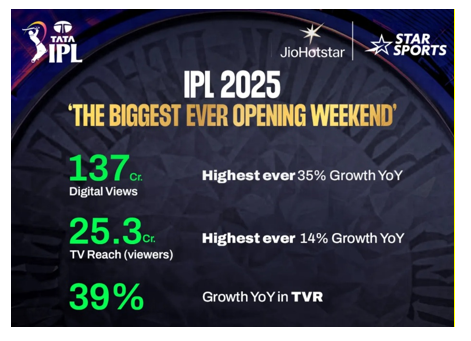
Figure 2: JioHotstar Witnessed 40% Growth in IPL 2025 Digital Viewership [8]
In 2024 March, IPL brand value stood at $10.7 billion, up 433% since its commencement in 2008. In March 2025, the estimated value was $12 billion.
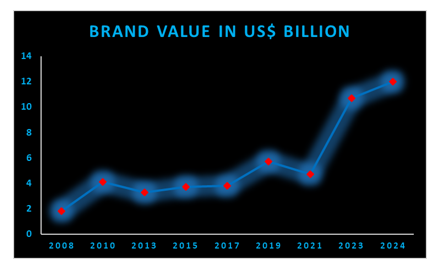
Figure 3: IPL Brand Value
In 2024 March, IPL brand value stood at $10.7 billion, up 433% since its commencement in 2008. In March 2025, the estimated value was $12 billion.
Chennai Super Kings (CSK) is the most valuable IPL team is, with its brand value estimated at $122 million. Mumbai Indians (MI) is a close second with its brand value at $119 million and Royal Challengers Bangalore (RCB) at $117 million.
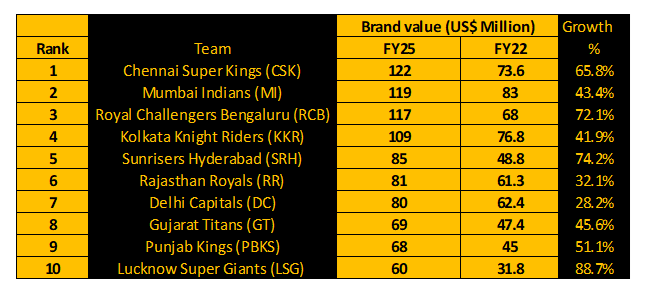
Figure 4: IPL Teams - Brand Values (Source: Moneycontrol)
CSK has 15 brands sponsoring the team for the 2024 season. The team's primary partners are TVS Euro grip, Etihad Airways, India Cement, and Gulf Oil. A strong brand presence helps team Chennai Super Kings draw a diverse group of sponsors supporting them [4]. Punjab Kings has more than 20 brands on-board as their sponsors. Gujarat Titans has 32 sponsors for IPL 2025, while Kolkata Knight Riders (KKR) sponsors grew from 21 to 25 [9].
Can you invest in these teams?
Most of the IPL teams are not publicly listed on stock exchanges. While a few teams may have a small number of unlisted shares available for purchase in the grey market, they are not generally traded like publicly listed companies.
CSK is the only team whose shares are available in the unlisted market for investors to put their monies in. This also creates an additional revenue source for the team other than sponsorship. An investor can put his money through a registered intermediary in CSK's shares which is the only one whose shares are being traded in the unlisted space.
To Conclude
Big events such as IPL pump in a lot of money into multiple industries and sectors and brings about a demand-led growth, creating new jobs, new markets and new opportunities. On the flip side, it causes a lot of environmental pollution. Carbon emissions rise due to increased transportation, use of fireworks, etc. Volume of waste multiplies. Massive consumption of electricity for lighting further increases carbon footprint. Domestic infrastructure is not in a position to offer green alternatives for all these.
While sustainability and green initiatives continue to remain on the nation's priority list events like IPL will never be stopped or even curtailed for the simple reason that the opportunities lost would be tremendous. The economic growth push will be favored at the cost of environment as India is still to reach the 'developed economy' stature. While attempts at diminishing environmental footprints will continue even like this will continue to thrive well drawing millions of Indians into the madness of spending just to be a part of the grandness and experience the festival called IPL.
References
[1] Times of India (ToI), "IPL 2025: 5 IPL teams that are no longer a part of the league and why," 27 Mar 2025. [Online]. Available: https://timesofindia.indiatimes.com/etimes/trending/ipl-2025-5-ipl-teams-that-are-no-longer-a-part-of-the-league-and-why/photostory/119595428.cms?picid=119595511. [Accessed 25 Apr 2025].
[2] M. Farooqui, "IPL brand value surges 77%; Mumbai Indians tops table," 22 Dec 2022. [Online]. Available: https://www.moneycontrol.com/news/trends/sports-trends/ipl-brand-value-surges-77-mumbai-indians-tops-table-9743711.html. [Accessed 24 Apr 2025].
[3] S. Singh, "In the big leagues now: IPL value grew by more than 400% in 15 years! |ndia Today," 23 Mar 2024. [Online]. Available: https://www.indiatoday.in/diu/story/in-the-big-leagues-now-ipl-value-grew-by-more-than-400-in-15-years-2518717-2024-03-23. [Accessed 04 Apr 2024].
[4] D. M. Benedict, Anjali A, M. Naik, I. A. Anthony and Manjula D, "An Economic Analysis of the Impacted Indian Premier League (IPL) on the Local Economy," SSRN, p. 29, 2025.
[5] BBC, "IPL media rights sold in record-breaking $6bn deal," 15 Jun 2022. [Online]. Available: https://www.bbc.com/news/world-asia-india-61793888. [Accessed 24 Apr 2025].
[6] Upstox News Desk, "India’s sports economy: The next $130 billion growth frontier," 25 Mar 2025. [Online]. Available: https://upstox.com/news/upstox-originals/investing/india-s-sports-economy-the-next-130-billion-growth-frontier/article-155473/. [Accessed 24 April 2025].
[7] The Hindu, "IPL 2025, IPL season 18: JioStar shatters viewership records on historic opening weekend," 28 Mar 2025. [Online]. Available: https://www.thehindu.com/sport/cricket/ipl-2025-ipl-season-18-jiostar-shatters-viewership-records-on-historic-opening-weekend/article69385372.ece. [Accessed 25 Apr 2025].
[8] SMEStreet, "JioHotstar Sees 40% Growth in IPL 2025 Digital Viewership," 30 Mar 2025. [Online]. Available: https://smestreet.in/sectors/jiohotstar-sees-40-growth-in-ipl-2025-digital-viewership-8906184. [Accessed 25 Apr 2025].
[9] M. Farooqui, "IPL 2025 drives new signings, over 20% more sponsorship revenue as teams remain on the front foot | Moneycontrol," 17 Mar 2025. [Online]. Available: https://www.moneycontrol.com/sports/ipl-2025-drives-new-signings-over-20-more-sponsorship-revenue-as-teams-remain-on-the-front-foot-article-12965962.html. [Accessed 25 Apr 2025].






